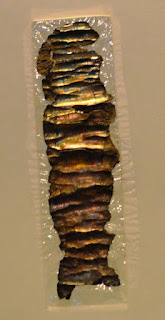There is so much to see and do in Jerusalem, let me catch up on a few more sights and experiences we had.
The Mehane Yehuda market is located in West Jerusalem. It is a bustling and crowded open air market that features all manner of food and other products.Just walking through the corridors of the market fills your senses with wonderful smells and sights in the midst of great diversity of people.
Another highlight in Jerusalem is the fantastic Israel Museum, which contains relics and artifacts covering the history of entire span of the region of Israel. Here are some sarchophagi,
This four-cornered pagan altar was found in Beersheba and dates to the 8th century BC
Here is the seal of Jezebel!
In the exhibit dealing with the time of Jesus, there is a copy of a heel bone pierced with an iron nail (the actual bone and nail date to the first century A. D., illustrating the type of method used in crucifixions at that time.
In addition to the indoor exhibits, the Museum contains a scale replica of Jerusalem as it was during the Second Temple era.
The Museum includes the Shrine of the Book which contains the Dead Sea scrolls found at Qumran.
Here is a mosaic of David playing the harp. From 508 AD
This is a silver amulet containing the oldest fragment of scripture found to date. This item dates to the 6th - 7th century B. C.
This plaque contains the epitaph for King Uzziah!
We spent the entire day wandering through the exhibits and could have spent several days trying to see it all. A great exhibit! The day we were there they also had a special exhibit of artifacts related to King Herod! I guess not such a big thing to those living in Jerusalem but to us it was amazing.
On a more sobering note, the Holocaust Museum in Israel is also located in Jerusalem, Yad Vashem (A Memorial and a Name). This is truly the most sobering and difficult exhibit I have ever visited. As you enter the museum area you walk along the Avenue of the Righteous Among the Nations, which highlights those Gentiles who aided the Jews during the time of the Holocaust.
This tree was planted in recognition of Corrie Ten Boom and her family.
This cattle car was used to haul Jews to one of the death camps.
The Hall of Remembrance is a dark tomb-like structure that bears the names of 21 of the main death camps. At the centre of the room is a casket of ashes from the cremation ovens and an eternal flame above it.
Uziel was one of the 6 millions Jews killed in the Holocaust, his parents funded the Children's Memorial where the names of each of the over 1 million children are read out with their ages.
The main part of the exhibit is a long corridor with 10 exhibition halls. Over 2,500 personal items have been donated by the survivors and their families. Each of the halls is dedicated to a different aspect of the Holocaust. The exhibit contains numerous videos of survivors retelling their experiences.
It truly is almost impossible to walk through and view these exhibits and realize the true horror that man in his prejudice and bias and hatred can inflict on other human beings.
We also were able to go to Bethlehem which is part of the West Bank, Palestinian Territories. The Church of the Nativity is an interesting building.
The building is actually three buildings connected--which can be identified by the three different crosses on the sections of the building.
St Catherine's Church which contains the tomb of Jerome
Church of the Nativity
Armenian Monastery
This area was identified as the place of Christ's birth since at least 160 A. D. The church was built by Constantine in 326 ( portions of the Mosaic floor from that time are still visible).
It was rebuilt by Justinian in 530 and the current Nave dates to that time as well.
Behind and below the altar is the Grotto of the Nativity.
There is a silver star on a marble slab that is over the spot where Christ is said to have been born.
The entrance to the Church of the Nativity is called the Door of Humility. The doorway was reduced in size by the Ottoman ruler to hinder horses, donkeys or camels from wandering into the building.
We also visited the site of the Shepherd's Fields.
The site contains a beautiful chapel.
Whose walls are covered with beautiful depictions of parts of the Christmas story.
Being in Jerusalem during Passover and Easter was a truly incredible experience. There is so much to see and do there--to actually see and walk through the places that are recounted in the Bible numerous times. It is clear that some of the places identified in Jerusalem today may not really be the actual place, but to know that it was in the general vicinity was truly thrilling. But as our tour guide said when we visited here two years ago, "People, People. It is not about the place. It is about the Person!" Truly it is!





























































